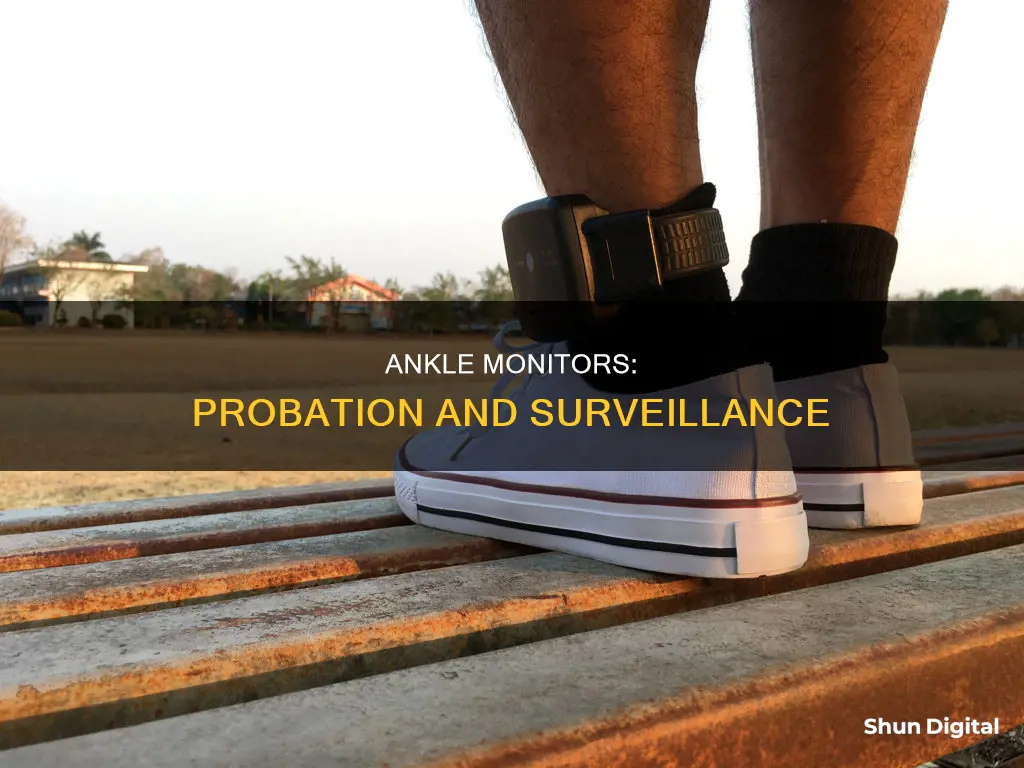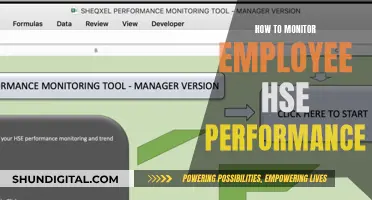
In the United States, ankle monitors are often used as a condition of probation, parole, or house arrest. The use of ankle monitors as a form of electronic tagging or surveillance allows law enforcement and probation officers to monitor an individual's location and ensure compliance with court-ordered restrictions, such as curfews or designated area limitations. While not everyone on probation is required to wear an ankle monitor, it is a common condition of probation in some states, such as Indiana. Ankle monitors are seen as a less harsh alternative to incarceration, allowing individuals to live in their communities while under supervision and specific conditions.
| Characteristics | Values |
|---|---|
| Used in | Indiana, Florida, Arizona, Brazil, South Africa, Australia, New Zealand, England, Wales |
| Purpose | Surveillance, monitor location, ensure compliance with court-ordered restrictions |
| Use cases | Probation, bail, parole, house arrest, immigration, healthcare |
| Technology | GPS, radio frequency, alcohol monitoring |
| Types | GPS monitors, RF monitors, SCRAM monitors |
| Cost | Up to hundreds of dollars for installation and monthly monitoring services |
| Payment | Paid by the person wearing the monitor |
| Removal | Attempting to remove or damage the device will send a signal to law enforcement |
| Non-compliance | May result in serious consequences, including prison time |
What You'll Learn
- Ankle monitors are used as a substitute for harsher penalties, such as incarceration
- The wearer typically has to pay for the device and monitoring services
- The monitor tracks the wearer's location and can be used to enforce curfews or designated area limitations
- In Florida, removing or damaging the device is a third-degree felony
- Monitors can be used pre-trial or as a condition of bail, probation, or parole

Ankle monitors are used as a substitute for harsher penalties, such as incarceration
Ankle monitors are often used as an alternative to incarceration, allowing individuals to live in their communities under specific conditions. In Indiana, for example, probation is a common substitute for imprisonment, offered when the crimes committed don't warrant jail time. Offenders on probation must adhere to the terms set by the court, which often includes wearing an ankle monitor.
Ankle monitors are used as a surveillance tool to track an individual's location and ensure compliance with court-ordered restrictions, such as curfews or designated area limitations. These devices can have a positive impact, as they allow individuals to avoid the negative consequences of incarceration, such as the potential for recidivism and the hardship of separation from family and community.
Additionally, ankle monitors can be used as a cost-effective measure for law enforcement and the criminal justice system. By keeping individuals out of jail, resources can be conserved, and the financial burden on the state is reduced. This also helps alleviate prison overcrowding, which is a prevalent issue in many jurisdictions.
The use of ankle monitors as a substitute for harsher penalties is particularly relevant for first-time offenders, individuals with mental health issues, or those convicted of non-violent crimes. It provides an opportunity for rehabilitation and reintegration into society, while still holding individuals accountable for their actions and ensuring they abide by the conditions set by the court.
In summary, ankle monitors serve as a viable alternative to incarceration, offering a balance between supervision and community integration. This measure allows the criminal justice system to address the specific circumstances of each case and make decisions that take into account the nature of the offense, the needs of the individual, and the overall well-being of the community.
Dodge Chargers: Blind Spot Monitoring Feature Explained
You may want to see also

The wearer typically has to pay for the device and monitoring services
The wearer typically has to pay for the cost of the device and monitoring services. Electronic monitoring (EM) fees can be some of the most costly, least transparent, and complicated charges in the criminal legal system. EM includes any technology used to track, monitor, or limit an individual’s physical movement or alcohol consumption. In most states, individuals on EM are required to pay daily, weekly, or monthly fees, or a flat rate. Failure to pay these fees can lead to extended supervision, additional fees, or even jail time.
The amount charged varies depending on the state and local legislation. Some states allow the EM provider, whether a government agency or a private company, to set fees as they see fit. Other statutes require that EM monitoring fees are "associated with the cost of monitoring", which could include device costs, supervision fees, administrative fees, staff salaries, and other expenses. This gives a wide scope for the total cost of the device and monitoring services.
There is a lack of transparency and consistency in the fees charged for EM services. While 43 states have rules that explicitly authorise fees for EM, the way these fees are calculated and imposed is often unclear. Only four states—Illinois, Kentucky, Missouri, and Nevada—take into account the person's ability to pay when assessing EM fees. This means that for most people, the financial burden of EM fees is a significant challenge, with little flexibility or consideration for their personal circumstances.
The financial implications of EM can be far-reaching and should not be underestimated. The high cost of these services, coupled with the potential for additional fees and extended supervision, can create a significant financial burden for the wearer. This burden is further compounded by the fact that these fees are often imposed on top of other court costs and legal fees. As a result, individuals may struggle to keep up with the payments, leading to further legal consequences.
Monitoring Printer Usage: Effective Strategies for Tracking and Management
You may want to see also

The monitor tracks the wearer's location and can be used to enforce curfews or designated area limitations
Ankle monitors are often used as a condition of probation, allowing law enforcement and probation officers to monitor an individual's location and ensure compliance with court-ordered restrictions. These restrictions can include curfews or designated area limitations, which, if violated, can result in serious consequences. For example, in Indiana, failure to comply with the terms of probation, including wearing an ankle monitor, can lead to the possibility of incarceration to complete the criminal sentence.
Ankle monitors typically use GPS technology to track an individual's movement in real time. This enables authorities to verify adherence to mobility restrictions, such as curfews or designated areas. The GPS technology communicates the wearer's location to a monitoring station via radio frequency signals. If an individual goes outside a specific perimeter, the monitor will alert the monitoring station, triggering a response.
The use of ankle monitors provides an alternative to incarceration, allowing individuals to remain in their communities while under supervision. The terms of probation, including the use of ankle monitors, are tailored to each case, taking into account the nature of the offense, the individual's needs, and the needs of the community. Ankle monitors are particularly useful in enforcing compliance with court-ordered restrictions, such as curfews or designated areas, by providing continuous location tracking.
It is important to note that not everyone placed on probation is required to wear an ankle monitor. The decision is based on various factors assessed by the court, including flight risk, substance abuse issues, or specific court orders. Additionally, in some jurisdictions, individuals may be required to pay for the cost of the ankle monitor, including installation and monitoring fees.
China's Internet Surveillance: Monitoring Online Activities
You may want to see also

In Florida, removing or damaging the device is a third-degree felony
In Florida, ankle monitors are used by the Department of Corrections to ensure individuals comply with the terms of their parole or probation. They are also used when a person is out on bail before a trial or sentencing. Ankle monitors are GPS devices that track the wearer's location and notify authorities if they move beyond a certain area.
Florida law states that you cannot attempt to remove, damage, or tamper with the device in any way. If you do, the device will automatically send a signal to the relevant law enforcement agency. Since House Bill 75 was passed in 2016, removing or tampering with an ankle monitor has been a third-degree felony. This is an addition to Florida Statute 843.23, which states that it is unlawful to:
> "Remove, destroy, alter, tamper with, damage, or circumvent the operation of an electronic monitoring device, which must be work or used by the individual pursuant to a court order or the Florida Commission on Offender review."
A third-degree felony conviction can carry punishments of up to $5,000 in fines and up to 5 years in prison. If you have two or more previous felonies, you may be labelled a habitual offender, which can enhance the penalty to up to 10 years in prison.
Connecting Dual Monitors with an HDMI Cord: A Simple Guide
You may want to see also

Monitors can be used pre-trial or as a condition of bail, probation, or parole
Ankle monitors are often used as a condition of probation, but they can also be used pre-trial or as a condition of bail or parole. In Indiana, for example, probation is a common alternative to incarceration, and ankle monitors are frequently used to enforce compliance with court-ordered restrictions. Similarly, in Florida, ankle monitors are used as a substitute for harsher penalties, such as incarceration, and are typically worn when a defendant is on house arrest, probation, or parole. They can also be ordered for a defendant prior to their trial.
The use of ankle monitors allows law enforcement and probation officers to monitor an individual's location and ensure they adhere to mobility restrictions, such as curfews or designated area limitations. These devices use GPS technology to track movement in real time, and some even include features like alcohol monitoring to detect and report the consumption of alcohol by the wearer.
The decision to impose an ankle monitor is based on various factors assessed by the court, including flight risk, substance abuse issues, and specific court orders. While ankle monitors can provide valuable surveillance and location data, they do not physically restrain the wearer from leaving a certain area or prevent them from re-offending.
In addition to the surveillance aspect, ankle monitors can also have financial implications for the wearer. In most cases, the individual wearing the ankle monitor is responsible for paying the associated costs, including installation and monitoring fees, which can amount to hundreds of dollars.
Monitoring Data Usage: Apps to Track and Control
You may want to see also
Frequently asked questions
An ankle monitor is an electronic device affixed to a person that is used as a form of surveillance. It is typically worn when a defendant is on house arrest, probation, or parole.
It depends on the jurisdiction and the nature of the offence. In some places, like Indiana, wearing an ankle monitor is a common condition of probation. However, it is not a mandatory requirement for everyone on probation.
Ankle monitors typically use GPS technology to track the wearer's location in real-time. Some devices may also include features like alcohol monitoring to detect and report alcohol consumption.
The rules for wearing an ankle monitor vary depending on the case, but some common rules include meeting with a probation officer, paying court fees, abstaining from drugs and alcohol, and staying within a specified geographic region.
Violating the terms of probation while wearing an ankle monitor can result in serious consequences. The monitoring station will be alerted if you go outside a specific perimeter or attempt to remove the device. This can lead to law enforcement apprehension, modification of probation conditions, or even imprisonment.







